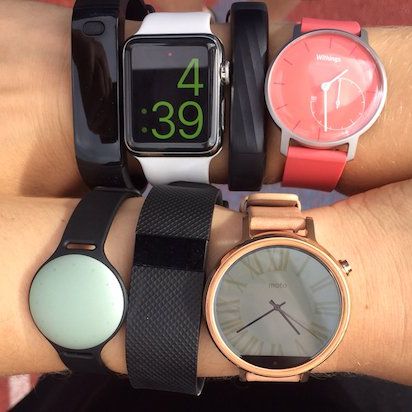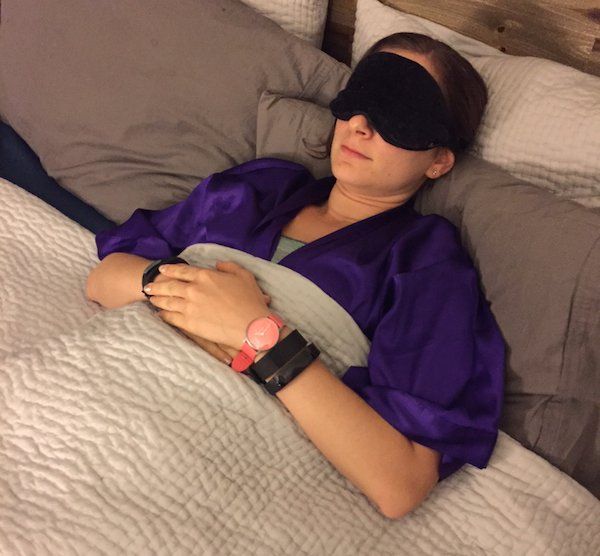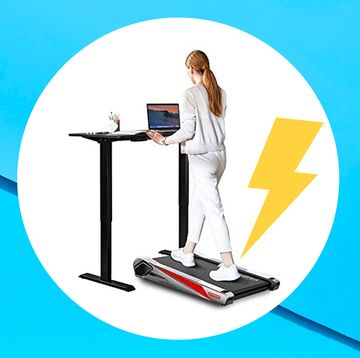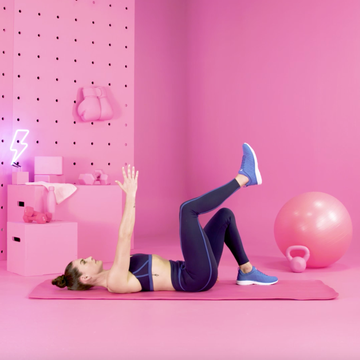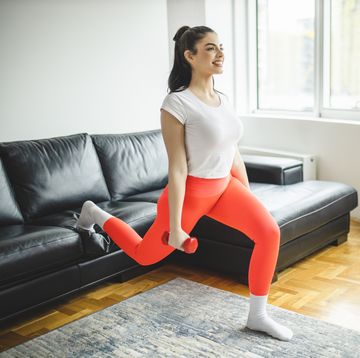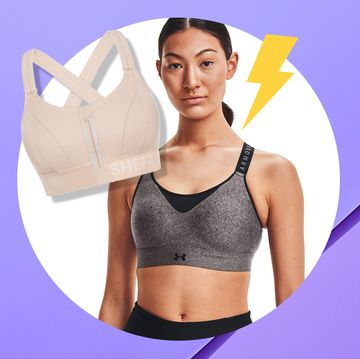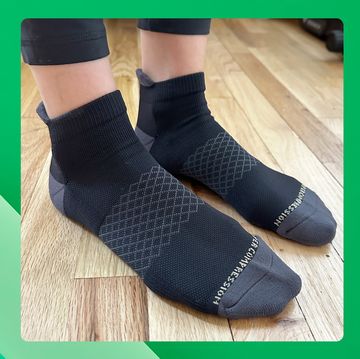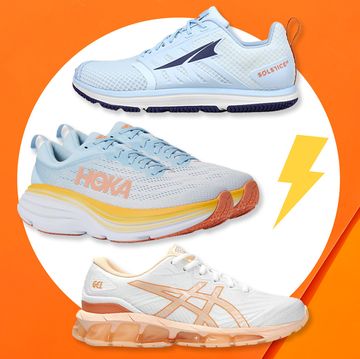Search for "fitness trackers" on Amazon.com, and you'll get, oh, 22,845 results. Picking the one you want to spend your hard-earned cash on can seem like a pretty daunting task.
Take a deep breath. In the name of helping you avoid fitness-tracker-buyers' remorse, I chose seven popular options and reviewed every aspect of them I could: I read the instruction manuals, sure, but I also wore the different models side-by-side to see what each clocked 100 steps at and how far each recorded a mile as being. I paid close attention to how user-friendly each one was, checked how accurate the heart-rate monitors were, and also tested the sleep functionality of the bands that promise to log your Zs. Here's what I found.
The Trackers
For the purposes of this story, I tried to stick to true fitness trackers (as opposed to running watches or other fitness-related devices you can wear on your wrist) with two big exceptions: the Apple watch and the Moto 360, one of several Android Wear options on the market. (I had to see if all the buzz is deserved because...journalism.) All of the options have the capability to track steps, distance, and calories burned—and some came with other features, too. Here’s a quick rundown of what you can expect from each watch:
Setup was pretty seamless with most of the devices with one big exception: I couldn’t get the Withings Acrtivité POP to sync with the phone. Granted, the watch has great reviews on Amazon.com (four out of five stars, on average, from 271 customer reviews) so my experience may be an anomaly. But while I had one false alarm when the hands on the watch started moving and I’d thought I succeeded, I couldn’t ever manage to sync successfully. An interesting thing about this watch, though, is that you’re instructed to keep your smartphone nearby at all times—it seems like your phone is what actually does all of the tracking and it just communicates that information to your watch to control where the hands are. So I decided to keep the watch (and coinciding app) in the test.
Counting Steps
Pedometer technology has been around for a while, so I wasn’t surprised to find that all of the watches were pretty accurate when it came to logging the 100 steps I took during my test run.
Each Fitness Tracker Logged 100 Steps As…
| Pivotal Living | 95 steps |
| Misfit Shine | 100 steps |
| Withings Activité POP | 101 steps |
| Apple Watch POP | 102 steps |
| Jawbone Up 3 | 102 steps |
| Fitbit Charge HR | 103 steps |
| Moto 360 | 107 steps |
If steps are your main priority, you’d be pretty good with any of these options.
Logging Distance
Here’s where things got interesting. None of these bands have the built-in GPS technology I’d recommend looking for if you’re training for a race and want to rely on a watch during your runs. Still, they all offer estimates of how far you’ve gone—so I hit the track to do four laps and see what each of the devices measured a mile as being.
This wasn’t as easy as it might seem. Since you can’t zero out your distance for the day on any of these trackers to conduct a test like this, I had to drag my boyfriend out to the track with me, read off all of the starting distances to him to write down in a notebook, run a mile, then (without moving at all), read off all of the ending distances to him (thanks, Matt!).
I also tested the Apple Watch and the Moto 360 twice: once without keeping my phone nearby to see how they did without any help from a 4G connection and once with my iPhone in-hand. Here’s how the fitness trackers did:
Each Fitness Tracker Logged a Mile As…
| Withings Activité POP | 0.02 miles* |
| Moto 360 | 0.74 miles |
| Fitbit | 0.83 miles |
| Apple Watch | 0.97 miles |
| Pivotal Living | 0.99 miles |
| Jawbone Up 3 | 1.1 miles |
| Misfit Shine | 1.1 miles |
*This corroborates my theory that the watch's app uses your smartphone's built-in technology since I ran without my phone during this mile.
Turns out, the Apple Watch and the Moto 360 don’t actually appear to use your phone’s GPS unless you turn on an app specifically designed to track your run. (Womp womp.) Since the Moto 360 doesn’t have a built-in app to do this (although this will change when the Moto 360 Sport is introduced with GPS technology), its reading came out virtually identical during my second mile: 0.73. When I used the Apple Watch’s “Workout” app, its reading actually came out slightly less accurate than the first time around: 1.06. *Shrugs*
Sleep Tracking and Other Functions
You didn’t think I stopped with the steps and distance, did you? Nope. I also wore these babies to bed (or at least the ones that promised sleep tracking, anyway).
The Misfit, Fitbit, and Jawbone all are supposed to track your sleep automatically (meaning you don’t have to push any buttons to put the device in “sleep mode”). They said I slept between nine hours, 14 minutes and nine hours, 49 minutes (sometimes I like to bank shuteye on Sunday nights, okay…?). They also said I woke up between zero and two times during the night. But since I can’t say for sure exactly when I fell asleep or how restful or restless my night was...there’s no way to know which device was the most accurate on this front. (Sorry, guys!)
The Pivotal Living band has a sleep-tracking mode that you can activate by double-clicking the button on it until you see a moon icon on the screen. But even though I did this, the band didn't seem to record my Zs; I didn’t see any relevant data on the app after I synced my tracker the next morning.
I also performed one other test: counting my actual heart rate and then using the devices that measure it to see how close they got. I’m happy to report that all of the trackers do a great job on this: The Fitbit was dead-on, the Apple Watch gave a reading 1.89 percent above my actual heart rate, and the Android 360 came in 9.43 percent above it (although my heart rate was 53, so a reading of 58 isn’t so far off).
You may have noticed that the Jawbone has heart-rate functionality but that I didn’t include it in this test. That’s because you can’t check your heart rate on demand with this device—but it’s constantly monitoring you to provide data on your resting and active heart rate. The app also provides lots of guidance on what all of the numbers mean, which is a definite plus (while the 10,000 step benchmark is easy enough to grasp, the other numbers can be tough to glean meaning from).
So...Which One Should You Buy?
Not to pull a Sarah Koenig on "Serial" on you, but...there’s no one clear-cut answer here. I didn’t want to leave you hanging, though, so I decided to give some guidance on who I think each tracker is perfect for.
If you’re on a budget: Even with the app renewal fees after your first year of membership, the $12 Pivotal Living band (pivotalliving.com) is the most affordable option out there. And for basic step counting, it definitely gets the job done.
If you’re more concerned with how it looks than anything else: Although I couldn’t get the Withings Activité POP (withings.com) to work myself, as I mentioned, the online reviews don’t reflect that other people had this issue—and I loved the coral-pink color.
If you never want to charge it: The Misfit Shine (store.misfit.com) comes with a replaceable coin cell battery that lasts for up to six months, so you don't have to worry about plugging it in once every few days—and can wear it to track your every movement.
If you want advanced tracking features...and to be able to see your exact step count on your wrist: While other devices have various symbols that indicate roughly how close you are to hitting your step goal, the Fitbit Charge HR (fitbit.com) has a screen that lets you check in on your precise progress throughout the day.
If you want more context for the numbers to really improve your health: The "Up" app that works with your Jawbone Up 3 provides personalized tips like “Your REM sleep is most likely to be disrupted in the morning, so it may be a good idea to put in ear plugs before you hit the hay."
If you want a smartwatch...and one that doubles as a conversation starter: People will come up to you and ask you what you think of the Apple Watch (apple.com/watch) all the time when you wear one. There’s no way around it. And I also liked that the watch buzzes to remind you to stand for at least one minute of each hour.
If you want a smartwatch...but don't want to look like you’re an extra on Star Trek: Everyone who saw me in the Moto 360 (motorola.com) commented on how impressed they were that it looked like a real watch. And now that Android Wear works with iOS, anyone with a smartphone can use it.
Still Can't Decide?
Lumoid (lumoid.com) lets you rent fitness trackers before buying them—and “Wearable Boxes” lend you up to five devices (including the Apple Watch and the Moto 360) for two weeks. There’s no fee if you buy a tracker through the site—and $25 for the box if you decide to return all of them.
Keep in mind: Anything that gets you moving more has done the job that a fitness tracker is supposed to do—and since all of these will have you walking laps in your living room to try to hit 10,000 steps, the one that appeals the most to you (and that you'll therefore be most likely to wear) is your best bet.
Robin Hilmantel is the digital director at Women's Health, where she oversees the editorial strategy for WomensHealthMag.com and its social platforms. She has almost 10 years of experience writing and editing for national publications, and more than 8 years of experience writing and editing health, fitness, and nutrition content specifically. In addition to Women's Health, her work has also appeared in TIME, Food Network Magazine, Cosmopolitan, New York Magazine, SELF, Glamour.com and other publications.
